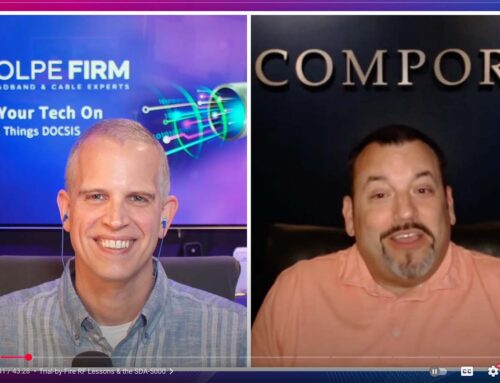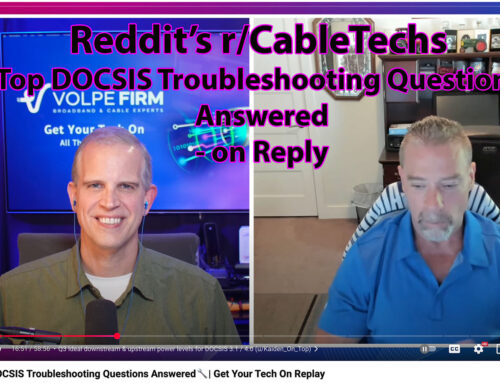Podcast: Play in new window | Download | Embed
Subscribe: Spotify | Email | RSS | More
Follow part 2 of this series on cloud native virtualization of DOCSIS and broadband networks? Brady Volpe and Asaf Matatyaou, Vice President, Solutions and Product Management, Cable Edge Business at Harmonic, explore this topic as it is becoming a big focus in the way we deploy and manage our networks through cloud native virtualization.
In this second installment we focus more on practical applications of virtualized CMTSs and answer more questions from our listeners. Part 1 of this series: https://youtu.be/IKbVYHYvrEc Upcoming events: https://volpefirm.com/broadband-event/
Listen or watch Brady and Asaf discuss virtualization and what it means to cable systems and networks. Sounds like something that is off in the future but really it is in use today. Virtualization is not in the future or a nebulous term. Find out more about what is going on with virtualization. So many questions and we have the answers.
Virtualization a Deep Dive Part Two Outline:
- Deploying on a virtual CMTS looks exactly the same as a regular CMTS when you are monitoring those from a monitoring platform standpoint
- Operational familiarity
- How do you use the product
- What is your interface to it?
- CLI – command line interface looks the same on both virtual or hardware CMTS
- SNMP – simple network management protocol – MER and SNR of cable modem – works the same on both virtual CMTS and hardware CMTS
- IPDR
- There will be a time when CLI and SNMP because they are older but not for a while
- Virtualization approach you can orchestrate it or API it
- Have intelligence by adding scale
- Richer metrics are available in virtual CMTS
- SNMP creates a load on CMTS and Cable Modem
- Using newer technology will allow you to get a stream of data not just every 15 minutes
- It can capture bursty noise not always captured by SNMP
- More information more frequently – streaming telemetry
- CIN – converged interconnect network
- How does communication work between the virtual CMTS and RPD
- Traditional HFC plant vs Virtual CMTS explained plant explained
- Benefits of digital fiber and multiple access devices
- Today 10G links or multiple 10G links
- DAA switches going to RPDs
- Volt – Virtual OLT can sit right next to the VCMTS
- Work loads
- Remote OLT device
- Multi-tenent applications living on the same platform
- Virtual CMTS or hardware CMTS connects to CIN (ethernet link) to replaces analog link you eliminate the analog portion of the network and replace it with the CIN
- Benefits of replacing digital with analog summary – faster speeds, better quality, etc. More bandwidth to more customers
- From an RF perspective you are also getting rid of laser clipping, you eliminate traditional issues with this portion of the analog network
- Cleaner more robust signal
- Lower maintenance costs – less components etc
- Power and cooling is substantially less
- 10G link to RPD or ONT
- Possibilities for cable operators to take advantage of discussed
- Change out from RF to optical
- RPDs daisy-chained explained
- Fiber shortages
- Use cases discussed
- Multiple Mac domains or PON OLTs
- Edge Commute discussed
- Kubernetes K8S, Containerization, pods, micro services, off the shelf service – (discuss more in detail in part one)
- It allows you to deploy non access specific applications – Ie DOCSIS or PON etc
- K8S allows you to turn on different pods or orchestrate applications
- CPU resources allows you to run compute nodes – not fiber nodes
- How many resources do I require to turn on this application – virtual nodes
- Pod unit of replication – each pod can be seen as a VCMTS or application
- Application has different Containers – scheduler, control panel messages, ranging etc
- You can have micro services and not have containers
- What mirco-service is not
- monolithic software – ie windows
- Discussion on micro-services
- More intelligence in RPDs
- More computational power close to the subscriber
- Third party integrations are possible
- Modems have compute power on them and become the next edge compute device
- Virtualization enables potential in the network but you first need a cloud native approach
- Ethernet ring instead of daisy chain?
End Podcast
Asaf thank you for your time today. This was a great episode. Our next Episode 63 in August 14th with John Downey.
You can watch us live or recorded on Youtube or listen to us on your favorite podcaster. Links to everything is on the volpefirm.com webpage.
If you have enjoyed this webcast, please do hit the subscribe button so that you never miss an episode.
Thank you so much for being here and we will see you next month.
Upcoming events can be seen under Broadband Events. Previous events can be seen under the blog.
- If you are watching this on youtube please hit the subscribe button!
- Let us know what you think and remember to share!
- You can find slides at the bottom of the page and some on slideshare.
- Find out about events or articles by following us on Twitter, LinkedIn or Facebook too.
Also available on iTunes, Google Podcasts, Spotify, vurbl see podcasts “get your tech on”.





Leave a Reply